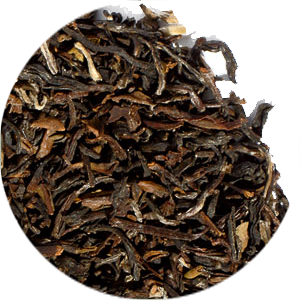Message

Castleton Darjeeling FTGFOP
Delicious tea from Castleton tea estate in Darjeeling province in India. Wonderful muscatel highlights with delicate strength - the hallmark of a premium Darjeeling.
Variant price modifier:
Sales price:
Discount:
Tax amount:
Country of Origin: India
Region: Darjeeling
Darjeelings are considered among the rarest and most prestigious of the black teas. The best grades are the whole leaf types with lots of ‘tip’. This Castleton Darjeeling has the highest grade F.T.G.F.O.P. (finest tippy golden flowery orange pekoe) and is one of the best darjeelings on the market.
The estate is near the town of Kurseong in the Darjeeling district of northern India. Castleton is one of the top estates in Darjeeling and consistently produces top teas - and, not surprisingly, obtains the top prices. The major method of transportation to Darjeeling is road (very treacherous) and a narrow gauge railway. In world terms the railway is almost considered a toy railroad system. The narrow gauge does not support large engines or carriages; also the steep inclines necessitate a cog system to prevent to trains from rolling backwards. Despite all the difficulties that must be contended with, the area produces the ‘Champagne of Tea’.
Produced in the Himalayas, Darjeelings are grown in the shadow of Kangchenjunga, the snow capped mountain said to be home of the Hindu God "Shiva" -the Destroyer. Darjeeling means land of the Thunderbolt and it is in fact the weather, combined with the attitude, soil and bright sunlight that result in an incomparable beverage.
The are 3 main times of year for producing good quality Darjeelings:
1st flush - Springtime harvested teas from late Feb. to mid April. The young leaves yield a light tea with generally intense muscatel with ‘point’. A gentle afternoon tea.
2nd flush - Harvested in June, these teas are more fully developed. The liquor is bright and the taste full and round excellent muscatel. A superb afternoon tea that is especially good with scones and raspberry conserve.
Autumnal - Not always available depending upon the weather, they are typified by a round taste and coppery liquor. Excellent as a breakfast tea with milk.
Brewing Tips - Hot Tea: This tea is best enjoyed using 2-3 heaping teaspoons for a 6-cup teapot. Allow the tea to steep for 3-5 minutes, remove the leaves and pour. We do not recommend adding milk or sugar since this can mask some of the intrigue and subtle nuances of this vintage tea.
Brewing Tips - Cold Tea: Place 6 teaspoons of tea into a teapot or heat resistant pitcher. Pour 1 1/4 cups of freshly boiled water over the tea. Steep for 5 minutes. Quarter fill a serving pitcher with cold water. Pour the tea into your serving pitcher straining the leaves. Add ice and top-up the pitcher with cold water. Garnish and sweeten to taste. A rule of thumb when preparing fresh brewed iced tea is to double the strength of hot tea since it will be poured over ice and diluted with cold water.
Region: Darjeeling
Castleton Darjeeling FTGFOP
Darjeelings are considered among the rarest and most prestigious of the black teas. The best grades are the whole leaf types with lots of ‘tip’. This Castleton Darjeeling has the highest grade F.T.G.F.O.P. (finest tippy golden flowery orange pekoe) and is one of the best darjeelings on the market.
The estate is near the town of Kurseong in the Darjeeling district of northern India. Castleton is one of the top estates in Darjeeling and consistently produces top teas - and, not surprisingly, obtains the top prices. The major method of transportation to Darjeeling is road (very treacherous) and a narrow gauge railway. In world terms the railway is almost considered a toy railroad system. The narrow gauge does not support large engines or carriages; also the steep inclines necessitate a cog system to prevent to trains from rolling backwards. Despite all the difficulties that must be contended with, the area produces the ‘Champagne of Tea’.
Produced in the Himalayas, Darjeelings are grown in the shadow of Kangchenjunga, the snow capped mountain said to be home of the Hindu God "Shiva" -the Destroyer. Darjeeling means land of the Thunderbolt and it is in fact the weather, combined with the attitude, soil and bright sunlight that result in an incomparable beverage.
The are 3 main times of year for producing good quality Darjeelings:
1st flush - Springtime harvested teas from late Feb. to mid April. The young leaves yield a light tea with generally intense muscatel with ‘point’. A gentle afternoon tea.
2nd flush - Harvested in June, these teas are more fully developed. The liquor is bright and the taste full and round excellent muscatel. A superb afternoon tea that is especially good with scones and raspberry conserve.
Autumnal - Not always available depending upon the weather, they are typified by a round taste and coppery liquor. Excellent as a breakfast tea with milk.
Brewing Tips - Hot Tea: This tea is best enjoyed using 2-3 heaping teaspoons for a 6-cup teapot. Allow the tea to steep for 3-5 minutes, remove the leaves and pour. We do not recommend adding milk or sugar since this can mask some of the intrigue and subtle nuances of this vintage tea.
Brewing Tips - Cold Tea: Place 6 teaspoons of tea into a teapot or heat resistant pitcher. Pour 1 1/4 cups of freshly boiled water over the tea. Steep for 5 minutes. Quarter fill a serving pitcher with cold water. Pour the tea into your serving pitcher straining the leaves. Add ice and top-up the pitcher with cold water. Garnish and sweeten to taste. A rule of thumb when preparing fresh brewed iced tea is to double the strength of hot tea since it will be poured over ice and diluted with cold water.
